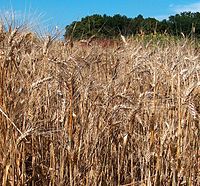
Photo from wikipedia
The close relationship between diet and health is generally recognized and the growing wellness and consciousness, especially in developed countries, have led to increasing interest for old wheat genotypes, based… Click to show full abstract
The close relationship between diet and health is generally recognized and the growing wellness and consciousness, especially in developed countries, have led to increasing interest for old wheat genotypes, based on perceived health benefits. Although nutritional comparison between old and modern wheat varieties is still controversial, it is generally accepted that old wheat genotypes remained unchanged over the last hundred years. By contrast, modern wheat genotypes are derived by modification of old wheats during the so-called "Green-Revolution" in the second half of the 20th century focusing on obtaining properties in terms of higher grain yield. The present work reports the first comprehensive proteomic profiling and qualitative comparison at the molecular level of metabolic and Chloroform-Methanol (CM)-like protein fractions extracted from mature kernels of two old Sicilian durum wheat landraces, Russello and Timilia Reste Bianche, and Simeto, an improved durum wheat variety widespread in Italy and other Mediterranean countries and chosen as representative of the most widely commercial cultivars. The results obtained reveal that metabolic and CM-like protein fractions of old and modern genotypes present remarkably high similarity with only minor differences. This leads to the conclusion that from a food and nutritional perspective there is a substantial equivalence of the protein composition of the old and modern cultivars. Data are available via ProteomeXchange with identifier PXD014449. BIOLOGICAL SIGNIFICANCE: In recent years consumers have shown growing interest in the old wheat genotypes, which are generally perceived more "natural" and healthier than modern ones. However, comparison of nutritional value for modern and old wheat varieties is still controversial suggesting further studies. In particular proteome analysis of old and modern wheat genotypes is currently ongoing with particular focus on gluten proteins, whereas the metabolic protein fraction has not yet been investigated. In the present study, we conducted a comprehensive proteomic profile and qualitative comparison at the molecular level of metabolic and Chloroform-Methanol (CM)-like protein fractions of the old Sicilian landraces Russello and Timilia Reste Bianche and the modern cultivar Simeto by applying a shotgun approach. The results reveal that the metabolic and CM-like protein fractions of old and modern genotypes are remarkably similar with only minor differences, leading to the conclusion that from a food and nutritional perspective there is a substantial equivalence of these cultivars. These results may contribute to improved understanding of the relationship between protein profiles of old wheat genotypes and their potential benefits for human consumption.
Journal Title: Journal of proteomics
Year Published: 2019
Link to full text (if available)
Share on Social Media: Sign Up to like & get
recommendations!